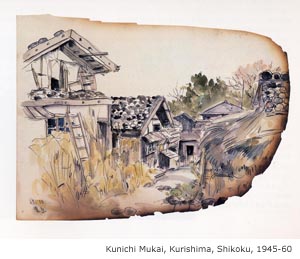
Ragged, charred, black edges show the tortuous story of survival for
some of Junichi Mukai's sketches. A fire in 1961, destroyed the artist's
studio and much of his art stored there. While many valuable works were
lost in the blaze, a number of sketchbooks survived. The sketches depict
old farmhouses and streets of rural Japan. Marooned in the middle of paper
that has been burnt all around, are images of old farmhouses. They appear
as if the fire stopped at the drawn building's doorstep. These partially
burnt sketches are strong metaphors for this artist life's work.
Junichi Mukai spent his lifetime drawing and painting Japan's old rural
buildings in a race to capture and preserve them. Like the burnt sketches,
Mukai perceived a ravishing ring of destruction surrounding these gracious
farmhouses. Old world Japan consumed by the fiery post war modernization
and economic development. An exhibition at the Setagaya Museum of Art,
a century past Mukai's birth, includes nearly 200 of his sketches, photographs
and oil paintings.
Junichi Mukai was born in Kyoto 1901. In 1927, after completing art training
he traveled to Europe to study oil painting. At the great European art
museums, he copied old master's paintings. On his return to Japan in 1933,
he established the studio, which was later destroyed by fire, at Tsurumaki,
in the Setagaya district of Tokyo.
Apart from a short period as wartime documentary filmmaker his creative
output was focussed exclusively on painting and photographing farmhouses
and rural landscapes. The Setagaya area was his base for over 50 years.
His second studio was built in 1962, also this area, included his house.
In 1993 this opened as an annex of the Setagaya Art Museum.
Mukai's painting style evolved slowly, from thick impasto in his early
works to a more delicate and detailed technique in his later years. However,
vibrant green and heavy brown dominate all of his works. The thick brown
paint he used to depict thatched rooves, stone fences, and wooden beams
conjures up thoughts of sticky mud in paddy fields. His paintings reek
of rich, fertile, composting earth.
A highlight of the exhibition is the many of the photographic images of
the same scenes depicted in the paintings on display. On his travels Mukai
collected many thousands of photographs of old buildings. He carefully
collated and recorded each of these in photo-journals. 91 bound photo-journals
encompassed his lifetime's pursuit of documenting Japan's rural past.
The photos also allow us to see how Mukai in his paintings censored out
the modern world. Telegraph poles and street signs are omitted and cars
removed from the streets. With our perspective from the 21st century it
would no doubt surprise Mukai that it is his photographs, which he began
taking in the 1960's, that are the most fascinating record. For it is
his photographs which record the old rural folk, working in the fields
and in their houses in the 1960's, which have vanished from modern Japan.
Mukai's editing of 'modernism' from his paintings removed the rural life
and makes them a cute but rather lifeless record of old architecture.
At the entrance to the exhibition is a half-reconstructed old farmhouse.
It offers a great chance to marvel at the building techniques and wood
craftsmanship of these buildings, which inspired this artist.
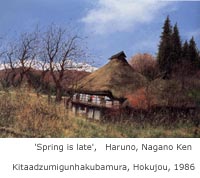
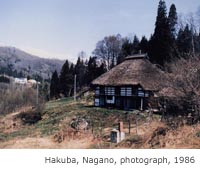
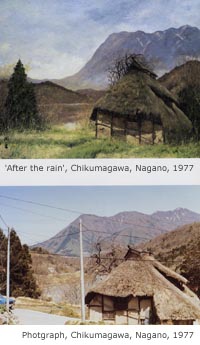
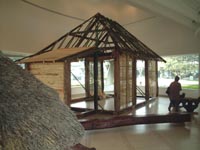
Setagaya Art Museum
Tel: 03-3415-6011 1-2 Kinuta-koen, Setagaya-ku